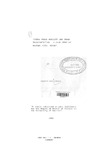| dc.description.abstract | Urbanisation has, of recent, become a focal point for
demographers, especially in developing countries. The
concern is due to the tempo if not the level of
urbanisation. The high growth rate of urban population
is accompanied by many socio-economic problems among them
urban public transportation. This study aimed at
evaluating the extent to which supply of urban public
transportation services has equalled demand ( a result of
the high urban growth rate) for such services in Nairobi.
Kenya Bus Services (KBS) and matatus were the public
transport carriers used in the evaluation.
Urban growth rate in Nairobi has been at 5 percent
and over per annum and is expected to continue at this
rate up to the year 2000: With rural-urban migration
having an upper hand in this urban-& growth, it is estimated
that at least 50 per cent of the urbanites in Nairobi will
be migrants by 1985 and at least 40 percent by the year
2000. The nature of spatial population distribution is
unfair to the urban poor because they are pushed to the
periphery hence forced to pay more for transport or walk
long distances to and from their work places.
Since 1934, KBS had monopolised the provision of
public transportation services until 1973 when matatus
were legalised to carry passengers through the Presidential
Decree (1973). The coming of matatus has been seen as
being inevitable since KBS had experienced deficits of
4.3 per cent and 2.2 per cent in their services provided
in 1962 and 1972 respectively. However, matatus have
brought some chaos with them: with no fixed fare-structure,
route schedule and separate bays, matatu operations have
been characterised by erratic random behaviour. They are
seen in every corner of the city as they lure customers
with the rampancy of overloading, overspeeding, obstructing
other road-users and jumping traffic lights. In spite of
their-evils, the services provided by matatus, as they
complement those from KBS, are indispensable, especially
at peak hour periods.
With the daily ridership in the region of 250,000
passengers in 1981, matatus increase has had a negative
effect on KBS operations whereby matatus had acquired 42
per cent of the market share in 1979. KBS has always
looked at matatus as uncalled for competitors hence the
campaign to annihilate them through reductions of fares
on various routes.
Proportion of potential passengers hence the level
of demand has been commensurate with increase in
population. Estimated at about 20 per cent of the total
population in Nairobi in 196?" the level of demand rose
to 25 per cent in 1972, 30 per cent in 1979 and 32 per
cent in 1981. It is expected that by 1985, the demand
level will still be 32 percent. Of the peopIe who use
either KBS or matatus, the mixed usage of the two has
resulted into KBS accounting for 60 per cent and matatus
40 per cent of the passengers carried (1981). Although
the availability of services increased with the corning
of matatus, the combined effort from KBS and matatus
still falls short of the demand. Overcrowded buses,
people stopping/hanging on matatus and buses/matatus
passing non-stop at intermediate bus-stops are common
sights during peak hours. While matatu services helped
to reduce the deficit percentage from 4.3 in 1962 to
2.0 in 1972, this percentage increased to 3.5 in 1979
and 5.3 in 1981. The least growth rate in the number of
matatus during the period 1979-1981 coupled with the
overhaul in the KBS operations then, are among the
causes for the rise in the deficit. With the assumption
that the population growth rate in Nairobi remains at
5 per cent and that the demand level remains at 32 per
cent of this population in 1985, the deficit in supply
will rise to 6.1 per cent.
Of the various implications that accrue from the
attempt of marching supply with demand include: more
and more people having to make most of their trips on
foot, both roads and vehicles being overworked due to
congestion hence accentuating the vulnerability of road
accidents, many semi and unskilled persons directly or
indirectly being employed in matatu-related jobs hence
a source of inducement for potential migrants.
Apart from the call for immediate attention on the
effective control of matatus, improvements on traffic
signals within the city centre, improvements on Juja
Road and sections of Jogoo Road that are past their
life-times, it is sincerely hoped that the situation in
Nairobi will be used as an example so that proper
planning and implementation of public transportation
services in our smaller towns that are growing can
avoid some of the mistakes. | en |

